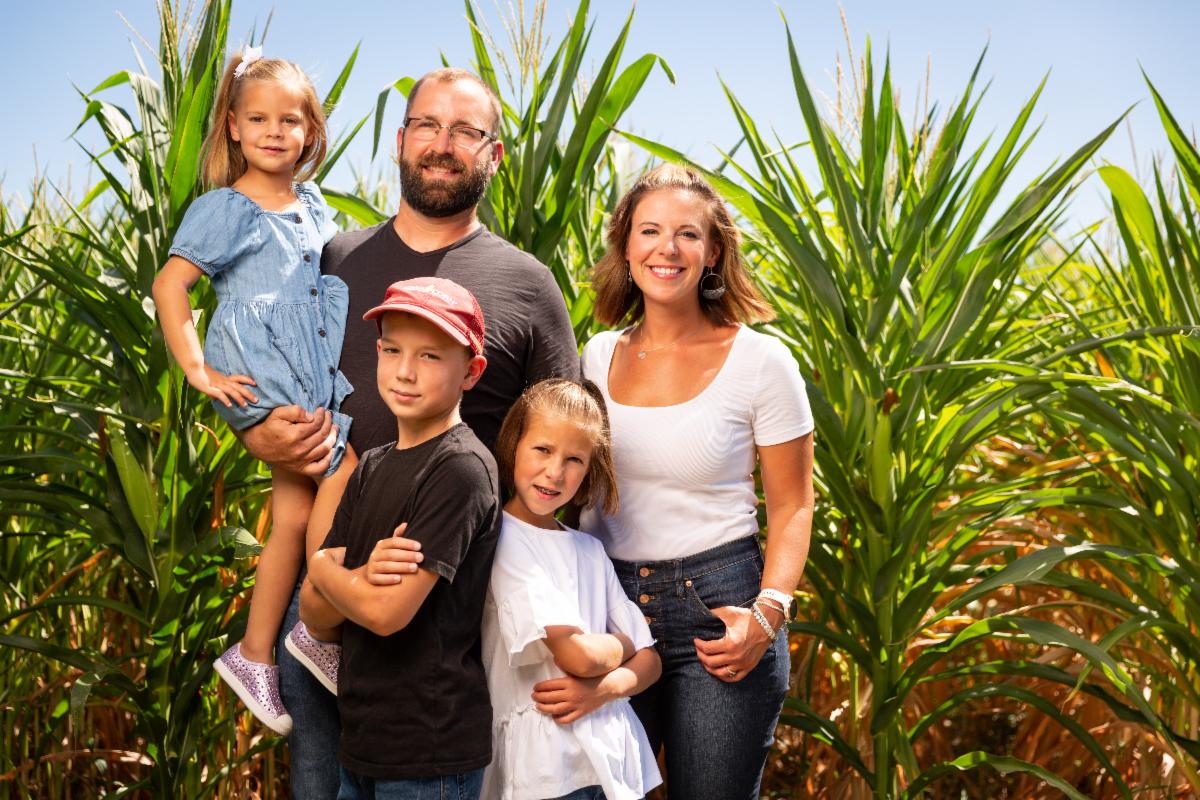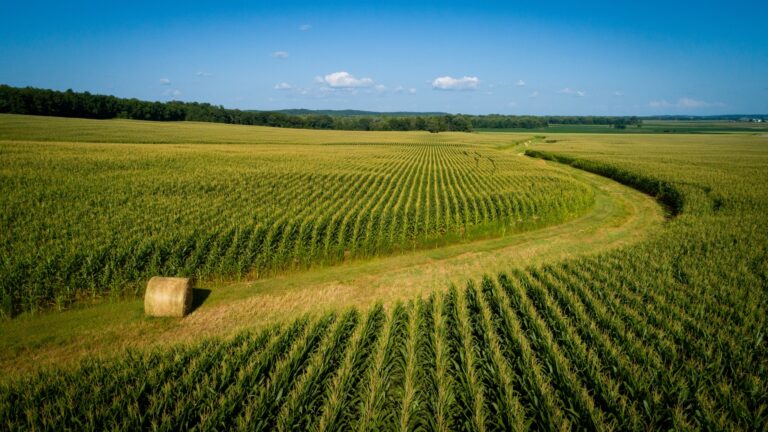2023 August Stewardship Advocate
PRE-HARVEST CONSIDERATIONS FOR CORN
Corn harvest is right around the corner and although this season’s crop is nearly finished developing, corn growers are making plans for harvest but also beginning to prepare for the next growing season. In this Stewardship Advocate, we preview some pre-harvest considerations for Iowa corn growers.
Pre-harvest Losses: Before harvest begins, check for your fields to estimate losses from dropped ears and kernels on the ground. A good rule of thumb is two kernels per square foot equals one bushel per acre yield loss. Estimating preharvest yield losses may help you determine if you are also experiencing yield losses from your combine and affect if and how adjust your combine header.
Stalk Quality: Stalk diseases are exacerbated by environmental stresses such as drought, foliar diseases and nutrient deficiencies. These conditions decrease photosynthesis during grain filling and make plants more susceptible to stalk diseases. Fields that are prone to stalk lodging due to disease pressure should be harvested earlier to avoid harvest losses due to lodging. Stalk quality of non-lodged plants can be checked by pushing stalks at the ear node, by squeezing stalks or splitting them 12’’ from the soil level.
Grain Quality: Ears rots and other ear and grain diseases can arise to hot and dry spells during the growing season followed by wetter conditions in September and October. Growers can observe grain quality by husking ears in multiples places in the field and looking for ear rots and other grain quality abnormalities. Grain quality and stalk quality can be checked at the same time prior to harvest.
Grain Moisture: Corn grain is around 32% moisture when it reaches maturity. When to harvest is determined by numerous factors including weather conditions, potential for ear drop and stalk diseases, grain prices and many others. Dry down of corn grain is dependent on the hybrid, temperatures and precipitation/humidity in the fall. Iowa State University (ISU) studied the rate of dry down in central Iowa and found high moisture corn (36-38%) needed around 35 days to reach 15.5% moisture while lower moisture corn (28%-30%) required about 25 days to reach 15.5%. Corn growers can also use the Corn Dry Down Calculator developed by ISU (see Corn Drydown Calculator) to estimate the decrease in grain moisture in the fall.
Hybrid Characteristics: Corn growers are always looking ahead so fall is a good time to evaluate hybrids prior to harvest and help them make decisions on what to plant the following season. Observations on late-season plant health, standability and other agronomic characteristics will go along with yield and grain quality to assist growers in making a post-harvest assessment of the hybrids they planted and feed into corn planting decisions for 2024.
Cover Crops: Decisions on planting cover crops also happen prior to harvest. Seed choices, planting method, rate and timing all play roles in the cover crop system. Growers that overseed cover crop seed into the standing corn crop will be ahead of the game because their cover crops will be seeded in August or September. Other growers will plant cover crops immediately after harvest. For these growers, it is important to plan ahead to allow cover crops to be planted in a timely manner following harvest.
While harvest is the culmination of the growing season, planning ahead and taking steps prior to combines running can make the harvest go more smoothly.
FARMER TO FARMER: Jerod Flaherty

Jerod Flaherty and his family farm outside of Osceola on a farm that the family has operated since 1934. Every fall is a season of anticipation, but it is also a season of preparation for Jerod as he gets ready for harvest. With the cool springs and earlier planting window the last few years, Jerod takes extra time to make sure his combine is ready to handle more grain and residue. He noted “With bigger yields, we are always looking for ways to manage the residue coming out of the back of the combine.” One way he does this is by turning out his cattle to graze the cornstalks after harvest which is a win-win to manage the residue and feed his cattle.
Calibrating yield monitors is performed using grain cart scales and then verified at his local cooperative. When and what harvest is multipronged decision this time of year. Jerod considers many factors in this decision, saying “We make harvest decisions based on crop maturity, weather, ground conditions and availability of help.” He increased his bin space this fall to avoid waiting in long lines at the elevator once harvest begins.
Jerod is also looking at his options for planting cover crops, saying, “Cover crops are being priced now and I am making the yearly decision on which cover crop seed application methods to use on my different fields. I am using aerial application for some acres, but I also drill cover crops after I chop corn silage. My remaining acres will get seeded when I apply dry fertilize and I use a harrow to incorporate the fertilizer and the seed.”
Jerod concludes by “Every growing and harvest season is different but making the proper preparations can pay dividends and save some headaches.”
LATEST INFORMATION:
Economics of Soil Health Systems on US Farms
Tile Drainage Spacing with The Highest Economic Return
Carbon Intensity Is Going To Be A Team Sport
How to Maximize Your Time Soil Testing
Iowa Awards $580K in Water Quality Funding to Improve Six Public Lakes
Saturated Buffers – Small Footprint with a Big Impact
Capturing, Reusing Water Gaining Renewed Interest
Moving Forward, More Ag Retailers Could Play a Role in Conservation Programs
UPCOMING EVENTS:
September 6: Iowa Nitrogen Initiative Field Day sponsored by Iowa Corn (10:00 am – 1:00 pm): Kluver ISU Research Farm, 1.5 miles west on 210th St from 500th St./Y Ave., Boone County
Iowa Learning Farms Webinars (all at 12pm CT) Iowa Learning Farms Events
- August 30: Rob Malone, Claire Phillips and Peter O’Brien, USDA-Agricultural Research Service; Corn Stover Harvest Impacts in Central Iowa
- September 6: Jeff Strock, University of Minnesota; Crop Response to Excess and Deficit Water Stress
- September 13: Nathan Nelson, Kansas State University; Cover Crop Impacts on Surface Runoff, Sediment, and Phosphorus Losses
Iowa State University Field Days ISU Research Farms Field Days
- August 31: Northeast Research Farm, Nashua, IA, Summer Field Day
- September 7: Southeast Research Farm, Crawfordsville, IA, Fall Field Day
- September 16: Horticulture Research Farm, Ames, IA, Fall Field Day
- September 8 (12:30-2:30 p.m.): Creating Space for Conservation and Regenerative Practices with Supportive Landowners; Josh Nelson & Family; 1243 Madison Ave. Belmond, IA 50421
- September 18-20: 2023 Iowa Water Conference; Altoona; 2023 Iowa Water Conference: Navigating Extremes
